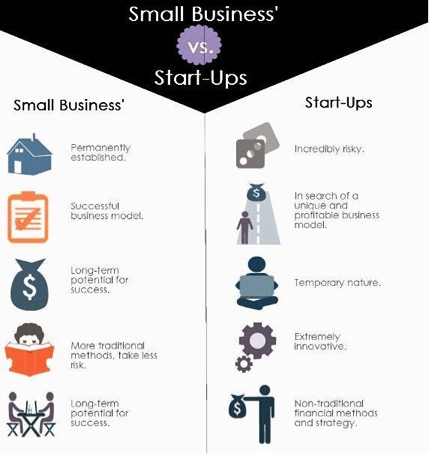
It’s no surprise that many are confused with start-ups and SMEs. They’re both established by entrepreneurs. They’re small in terms of revenue and number of employees.
So, how are they different?
Well, both are pursuing different business models and with significant differences in intent, function and funding options. Let’s see how different are their business models and their respective focus.
Start-Up

A start-up is temporary (usually lasts for 6 months) and it’s all about trial and error. According to Steve Blank, a start-up, is a “temporary organization designed to search for a repeatable and scalable business model”.
So at this point, the business model for a start-up is unstable and risky so it’s up to the entrepreneur to make it sustainable eventually. For a start-up, it’s all about experimenting and testing your business model. So perhaps, you’re uncertain about your target group or you are looking for a proper channel. Then you’ll start experimenting and searching for answers to the product you’re trying to sell, checking out the market’s niche and how to maximize your revenue from the right customers. Finally, you’ll be able to grow it faster once your business model is settled and stabilized.
There are two outcomes from starting a start-up – it’s either you succeed or fail.
If you’re successful, you exit your start-up phase and become a real business. From there, you focus more on executing the proven business model for a longer term and changing your temporary organisation to a more structured one.
On the other hand, if you fail to find the repeatable and scalable business model within your funding capacity, you will exit your start-up phase and move on to other opportunities. In the start-up scene, it is not a surprise that only one in 10 will survive.

A prominent start-up to look out for in 2016 is like Bfab. Bfab consists of a team who are passionate about internet start-ups and ecommerce that focus on beauty and wellness and also looking to building something sustainably that will change the entire industry.
Small Medium Enterprise

An SME is more permanent and it starts out with a structured organisation that focuses on the delivery of value to its already-known customers. An SME does not need to change its business model. Which means, at this stage, an SME is established with a stable and successful business model.
SMEs are driven by making a profit and intend to secure a financially sustainable spot in a local market for the long run.

Malaysian SMEs can be grouped into Small or Medium enterprises. These groupings are decided based on either the numbers of people a business employs or on the total sales or revenue generated by a business in a year as you can refer the table above provided by SME Corp Malaysia.

Featured in SME Annual report 2014-15, Lunatots is one of the greatest SME success stories to be told, having both online and physical presence. Founded in 2007 and with nine retail outlets in Malaysia currently, Lunatots Online Store and Lunatots Retail Outlets provides reliable breastpump, breastfeeding accessories and Lunatots cloth diaper products.
